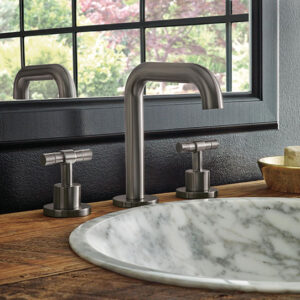🚰 Touchless Faucets & Soap Dispensers
The specification process of touchless faucets and soap dispensers is not just about choosing fixtures. It’s about transforming these everyday objects into strategic building assets — ones that:
1. Anchor Compliance
Properly specified products ensure alignment with ADA accessibility, UPC/IPC plumbing codes, and NSF/ANSI lead-free standards. By documenting compliance in the spec stage, architects prevent inspection failures, project delays, and costly retrofits. Instead of being a potential liability, the fixture becomes a compliance anchor that safeguards approvals and protects owners from legal exposure.
2. Elevate Hygiene
In high-traffic environments—airports, hospitals, universities, and malls—restrooms are touchpoints of public health risk. Touchless faucets and dispensers reduce cross-contamination by eliminating shared surfaces, while foam soap delivery ensures more effective handwashing. A specification rooted in hygiene metrics turns these fixtures into part of the building’s infection-control infrastructure.
3. Drive Sustainability
Well-specified touchless systems include flow restrictors (0.35–0.5 GPM), foam soap technology, and multifeed reservoirs that reduce water and consumable use by 30–50%. These performance features contribute toward LEED and WELL building credits, positioning restrooms as contributors to sustainability goals rather than resource drains.
4. Control Operational Costs
Off-the-shelf fixtures often fail prematurely, leading to expensive repairs and maintenance. Specifications ensure fixtures meet cycle-life testing (≥300,000 activations), use dual power systems, and include IoT-enabled monitoring for predictive maintenance. This transforms a potential maintenance liability into a cost-efficient operational asset with measurable ROI.
5. Reinforce Design Integrity
Fixtures are not isolated objects—they are visible extensions of the overall design. A specification ensures finishes (Matte Black, Brushed Gold, Chrome, Stainless Steel) are consistent across faucets, dispensers, and flush valves, aligning with architectural intent. This preserves brand identity in hospitality, retail, and institutional projects, turning restrooms into aesthetic statements rather than afterthoughts.
6. Build Professional Trust
For architects and engineers, specifying with confidence demonstrates mastery of codes, technology, and lifecycle economics. It shifts their role from product selector to strategic advisor, strengthening client trust. The result is a building where owners, operators, and users see restroom fixtures not as commodities, but as well-planned assets integrated into the long-term success of the facility.
✅ Final Takeaway
Touchless faucets and soap dispensers, when specified with precision, anchor compliance, elevate hygiene, drive sustainability, control costs, reinforce design integrity, and build professional trust. They cease to be “just fixtures” and instead function as strategic assets — delivering long-term value across legal, operational, environmental, and experiential dimensions of the building.

No responses yet